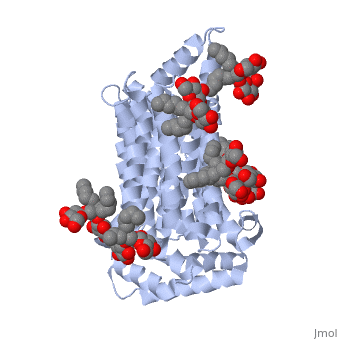This is a default text for your page Sanbox glut3. Click above on edit this page to modify. Be careful with the < and > signs.
You may include any references to papers as in: the use of JSmol in Proteopedia [1] or to the article describing Jmol [2] to the rescue.
Function
GLUT3 is one of fourteen facilitative sugar transporters which use the glucose diffusion gradient to move across various plasma membranes to display various specificities, kinetics and tissue expression profiles (Long et al. 2015). Glucose transporters are about 500 amino acids in length and are a part of a growing superfamily of integral membrane glycoproteins that have 12 transmembrane (TM) helices. The transmembrane regions presumably create channels through which glucose can move (Kipmen-Korgun et al. 2009). GLUT3 is categorized as a Class I transporter due to its protein sequence and structural similarity to other glucose transporters grouped in Class I (Long et al. 2015). GLUT3 displays the highest affinity for glucose of all of the Class I glucose transporters and has a transport capacity five times greater than that of GLUT1 and GLUT4 (Simpson et al., 2008). In humans, GLUT3 is found predominantly in brain tissue, highly and specifically expressed by neurons, and has some expression in peripheral tissues (Maher et al., 1994; Simpson et al. 2008). It is commonly known as the “neuronal glucose transporter” because of it is most commonly found in the brain, specifically seen mostly in the axons and dendrites of neurons (Simpson et al. 2008). GLUT3 has a more restricted expression pathway, which represents specialized functions for the protein (Xu et al., 2015). GLUT3 has been found to play an important role in gestational development and maintaining the brain's structure. Defects in GLUT3 can cause fetal death as well as neurodegeneration, which can lead to diseases like Alzheimer’s (Liu et al. and Zu et al. 2008).
Structure
Disease in Humans
Alzheimer’s disease, shows levels of impaired glucose uptake and metabolism, which leads to the downgrade of many other factors in the brain. GLUT3 is responsible for transporting glucose from extracellular space to neuronal tissue (i.e. dendrites and axons). Decreased levels of GLUT3 in Alzheimer brain shows a positive correlation to decreased levels of N-acetylglucosamine. The impaired presence of GLUT3 leads to hyperphosphorylation of the Tau protein, which normally stabilizes neuronal microtubules. Lastly there is a reduction in the transcription for factor hypoxia-inducible factor 1, which plays a role in glucose metabolism in the brain. The comparison between a normal healthy brain and an Alzheimer brain relieved that there was a 25-30% decrease in GLUT3 levels in the Alzheimer brain.
Relevance
Structural highlights
This is a sample scene created with SAT to by Group, and another to make of the protein. You can make your own scenes on SAT starting from scratch or loading and editing one of these sample scenes.

